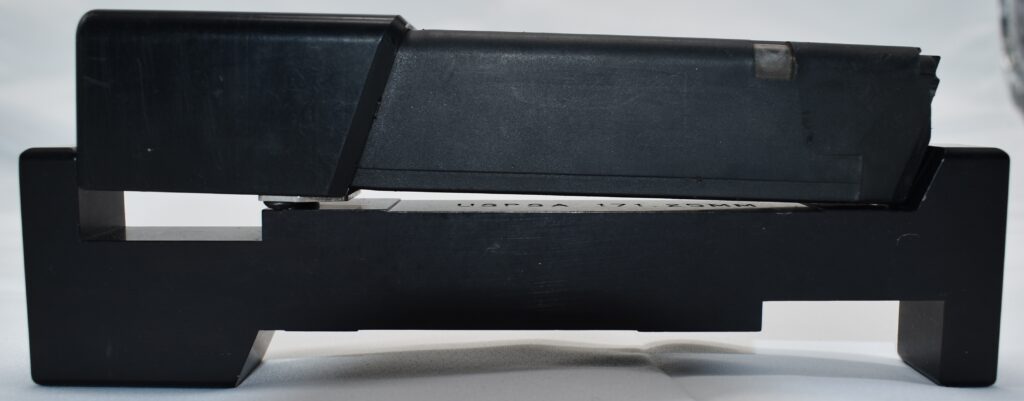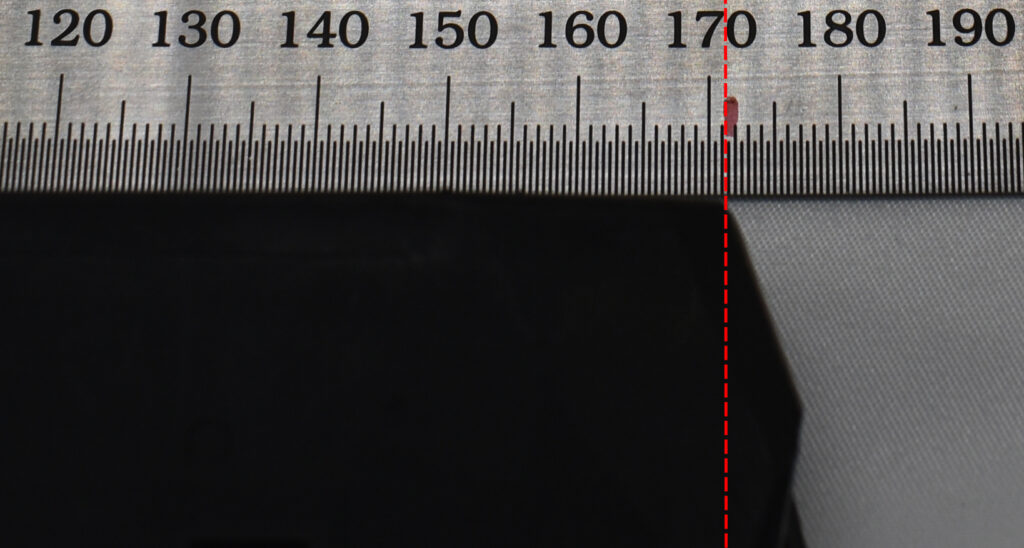While the easiest way to measure magazine lengths is with the official USPSA magazine gauge made by EGW, the rulebook does offer an alternative method using a ruler in Appendix E1. But why? Well, because sometimes magazine base pad extensions are shaped differently enough to cause issues.
We have covered how to properly use a mag gauge here on the blog and in a NROI Tips video. But what if the shape of the magazine base pad extension prevents the back of the mag from lying flat on the gauge? There are some mag extensions out there that are longer than the notch provided on the mag gauge or are built with enough extra material on the back side to be deeper than the notch in the mag gauge. This is when the technique in App. E1 is used.
Here is an example of a mag extension that goes on a factory mag to result in a magazine legal for use in Open Division. Notice how the mag extension is longer than the notch on the gauge and as a result the magazine cannot lie flat on the gauge.

This is were the range official checking magazine length needs to get out a good quality ruler, find a flat surface, good lighting, and probably a magnifier to be able to read the ruler. And while calipers would be a better tool, I tried those. You need two flat surfaces to accurately measure with calibers. The lips on on the back of the magazine are not flat!
When I say a good ruler, I mean a ruler with appropriate increments. I obtained a machinists ruler which has fine graduations for both inches and millimeters. Appendix D in the rulebook lists the maximum mag length for each applicable division in both inches and millimeters. However, rulers don’t have the inch increments in decimal like the rulebook lists, you will need a ruler that uses increments of 64ths. So make sure you know which 64th you need. According to a conversion chart I found on the internet, a 6.742″ Open magazine measurement is between 6 47/64″ and 6 48/64″. If we look at the 5.561″ mag length, which is commonly used in Limited and Carry Optics, that is between 5 35/64″ and 5 36/64″. If we use metric scale, which as a scientist I am more comfortable with, the finest increment ruler I found is 1/2 a millimeter. So the lengths of 171.25 mm and 141.25 mm are still a bit challenging, but the metric scale is easier to measure with because the value you are looking for is centered between two hash marks.

So how to measure using the ruler? First you need a flat surface. Preferably a smooth, flat table where you can stand the ruler on end along the magazine standing on it’s base pad. Make sure the ruler and back of the magazine are parallel with each other. And then get your eyes level with the back edge of the magazine and read the measurement. Yeah, that is why I mentioned good lighting and a magnifier (if you still have young eyes, you will see what I mean after you turn 40).
I am not going to tell you that reading the ruler is going to be easy. Especially when the target measurement on the ruler is in between increments, but do the best you can. And also remember that this technique should only be used for magazines with base pads that are not compatible with the magazine gauge. For mags with base pads that are compatible, it is much quicker and easier to use the USPSA Magazine Gauge.
So does this mag pass? Here is a close up look at the ruler, and yes when I took the picture I wasn’t exactly sure until I zoomed in on the picture. I added the dashed red line to indicate where the target length is. The rear of the magazine is right below the line, so this magazine passes.

Just remember to always measure your magazines before going to a match. It is much better to discover your mags are too long before you leave so you can make modifications before the match, it usually only takes a bit of sanding to fix minor length issues. Also, don’t have any mags that you know are too long anywhere in your match day range bag. It’s best to leave those illegal practice mags at home so they don’t accidentally get used or given to chrono.